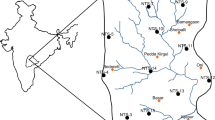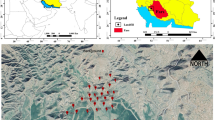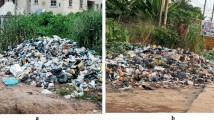Abstract
The composition of heavy metals (and metalloid) in surface soils of iron ore mine-impacted areas has been evaluated of their potential ecological and human health risks. The mining areas included seven selected locations in the vicinity of active and abandoned iron ore-mining sites in Pahang, Malaysia. Heavy metals such as Fe, Mn, Cu, Zn, Co, Pb, Cr, Ni, and Cd and metalloid As were present in the mining soils of the studied area, while Cu was found exceeding the soil guideline value at all sampling locations. However, the assessment of the potential ecological risk index (RI) indicated low ecological risk (RI between 44 and 128) with respect to Cd, Pb, Cu, As, Zn, Co, and Ni in the surface soils. Contributions of potential ecological risk \( \left({E}_r^i\right) \)by metal elements to the total potential ecological RI were evident for Cd, As, Pb, and Cu. Contribution of Cu appears to be consistently greater in the abandoned mining area compared to active iron ore-mining site. For non-carcinogenic risk, no significant potential health risk was found to both children and adults as the hazard indices (HIs) were all below than 1. The lifetime cancer risk (LCR) indicated that As has greater potential carcinogenic risk compared to other metals that may induce carcinogenic effects such as Pb, Cr, and Cd, while the LCR of As for children fell within tolerable range for regulatory purposes. Irrespective of carcinogenic or non-carcinogenic risk, greater potential health risk was found among children (by an order of magnitude higher for most metals) compared to adults. The hazard quotient (HQ) and cancer risk indicated that the pathways for the risk to occur were found to be in the order of ingestion > dermal > inhalation. Overall, findings showed that some metals and metalloid were still present at comparable concentrations even long after cessation of the iron ore-mining activities.



Similar content being viewed by others
References
Australian Department of Environment and Conservation (2010) Contaminated Sites Management Series: Assessment Levels for Soil, Sediment and Water. Department of Environment and Conservation, Bentley
Canadian Council of Ministers of the Environment (2007) CCME Soil Quality Index 1.0: Technical Report. In: Canadian environmental quality guidelines, 1999, Canadian Council of Ministers of the Environment, Winnipeg
Carvalho PC, Neiva AM, Silva MM, Santos AC (2016) Human health risks in an old gold mining area with circum-neutral drainage, Central Portugal. Environ Geochem Health. doi:10.1007/s10653-016-9806-4
Chen YZ, Yang H, Zhang ZK, Qin MZ, Jin F, Lu JJ (2007) Application of equilibrium partitioning approach to the derivation of sediment quality guidelines for metals in Dianchi Lake. Pedosphere 17(3):284–294
Clemens S (2006) Toxic metal accumulation, responses to exposure and mechanisms of tolerance in plants. Biochimie 88(11):1707–1719
Dzick W, Carlson R (2012) Monument Mining Limited: Mengapur Project, Pahang State, Malaysia. Project No.V1165, Amended Technical Report, January 26, 2012, Vancouver Canada, p 75
Gomez P, Valente T, Braga MAS, Grande JA, de la Torre ML (2016) Enrichment of trace elements in the clay size fraction of mining soils. Environ Sci Pollut Res 23:6039–6045
Guo G, Wu F, Xie F, Zhang R (2012) Spatial distribution and pollution assessment of heavy metals in urban soils from southwest China. J Environ Sci 24:410–418
Hakanson L (1980) An ecological risk index for aquatic pollution control. A sedimentological approach. Water Res 14(8):975–1001
Iqbal J, Shah MH (2014) Occurrence, risk assessment, and source apportionment of heavy metals in surface sediments from Khanpur Lake, Pakistan. J Anal Sci Tech 5:28
Jarup L (2003) Hazards of heavy metal contamination. Bri Med Bull 68:167–182
Karim Z, Qureshi BA (2014) Health risk assessment of heavy metals in urban soil of Karachi, Pakistan. Hum Ecol Risk Assess 20(3):658–667
Khan S, Cao Q, Zheng YM, Huang YZ, Zhu YG (2008) Health risks of heavy metals in contaminated soils and food crops irrigated with wastewater in Beijing, China. Environ Pollut 152:686–692
Kusin FM (2013) A review of the importance of hydraulic residence time on improved design of mine water treatment systems. World Appl Sci 26(10):1316–1322
Kusin FM, Zahar MSM, Muhammad SN, Mohamad ND, Zin ZM, Sharif SM (2016b) Hybrid off-river augmentation system as an alternative raw water resource: the hydrogeochemistry of abandoned mining ponds. Environ Earth Sci 75(3):1–15
Kusin FM, Muhammad SN, Zahar MSM, Zin ZM (2016a) Integrated river basin management: incorporating the use of abandoned mining pool and implication on water quality status. Desalin Water Treat. doi:10.1080/19443994.2016.1168132
Lee JS, Chon HT, Kim KW (2005) Human risk assessment of as, Cd, Cu and Zn in the abandoned metal mine site. Environ Geochem Health 27(2):185–191
Lee SW, Lee BT, Kim JY, Kim KW, Lee JS (2006) Human risk assessment for heavy metals and as contamination in the abandoned metal mine areas, Korea. Environ Monit and Assess 119(1–3):233–244
Lei P, Zhang H, Shan B, Lv S, Tang W (2016) Heavy metals in estuarine surface sediments of the Hai River basin, variation characteristics, chemical speciation and ecological risk. Environ Sci Pollut Res. doi:10.1007/s11356-016-6059-9
Li Z, Ma Z, Kuijp TJ, Yuan Z, Huang L (2014) A review of soil heavy metal pollution from mines in China: pollution and health risk assessment. Sci Total Environ 486–469
Liao J, Wen Z, Ru X, Chen J, Wu H, Wei C (2016) Distribution and migration of heavy metals in soil and crops affected by acid mine drainage: public health implications in Guangdong Province, China. Ecotox Environ Safe. 124:460–469
Lim HS, Lee JS, Chon HT, Sager M (2007) Heavy metal contamination and health risk assessment in the vicinity of the abandoned Songcheon Au-Ag mine in Korea. J Geochem Explor 98:223–230
Liu L, Zhang X, Zhong T (2016) Pollution and health risk assessment of heavy metals in urban soil in China. Hum Ecol Risk Assess 2(2):424–434
Luo XS, Ding J, Xu B, Wang YJ, Li HB, Yu S (2012) Incorporating bioaccessibility into human risk assessments of heavy metals in urban park soils. Sci Total Environ 424:88–96
Majid AA, Shaharudin HM, Alias S, Adnan E, Hassan AIA, Ali MZ (2013) Malaysian Mining Industry, Minerals and Geoscience Department Malaysia, Kuala Lumpur, p 152
Mamat Z, Haximu S, Zhang Z, Aji R (2016) An ecological risk assessment of heavy metal contamination in the surface sediments of Bosten Lake, northwest China. Environ Sci Pollut Res. doi:10.1007/s11356-015-6020-3
Olawoyin R, Oyewole SA, Grayson RL (2012) Potential risk effect from elevated levels of soil heavy metal on human health in the Niger Delta. Ecotox Environ Safety 85:120–130
Pan Y, Li H (2016) Investigating heavy metal pollution in mining brownfield and its policy implications: a case study of the Bayan Obo rare earth mine, Inner Mongolia, China. Environ Manag. doi:10.1007/s00267-016-0658-6
Pandey B, Agrawal M, Singh S (2016) Ecological risk assessment of soil contamination by trace elements around coal mining area. J Soils Sediments 16:159–168
Perez-Vazquez FJ, Flores-Ramirez R, Ochoa-Martínez AC, Carrizales-Yáñez L, Ilizaliturri-Hernández AC, Moctezuma-González J, Pruneda-Álvarez LG, Ruiz-Vera T, Orta-García ST, González-Palomo AK, Pérez-Maldonado IN (2016) Human health risks associated with heavy metals in soil in different areas of San Luis Potosi, Mexico. Hum Ecol Risk Assess 22(2):323–336
Praveena SM, Pradhan B, Ismail SNS (2015) Spatial assessment of heavy metals in surface soil from Klang District (Malaysia): an example from a tropical environment. Hum Ecol Risk Assess 21:1980–2003
Sheela AM, Letha J, Joseph S, Thomas J (2012) Assessment of heavy metal contamination in coastal lake sediments associated with urbanization: South Kerala, India. Lakes Reserv Res Manag 17(2):97–112
Taylor D (1971) An outline of the geology of the Bukit Ibam orebody, Rompin, Pahang. Bulletin No 4, Geological Society of Malaysia, June 1971, pp 71–89
UK Environment Agency (2008) Assessment of Metal Mining-Contaminated River Sediments in England and Wales. Science Report: SC030136/SR4, Environment Agency, Bristol
US Environmental Protection Agency (USEPA) (1996). Acid digestion of sediments, sludges and soils. Method 3050B
US Environmental Protection Agency (USEPA) (2002) Supplemental guidance for developing soil screening levels for superfund sites, OSWER 9355. Office of Emergency and Remedial Response, Washington
US Environmental Protection Agency (USEPA) (2011) Exposure factors handbook. National Center for Environmental Assessment, Washington, DC (EPA/600/R-09/052F)
US Environmental Protection Agency (USEPA) (2012) Integrated risk information system of the US Environmental protection agency
Wei X, Han L, Gao B, Zhou H, Lu J, Wan X (2016) Distribution, bioavailability, and potential risk assessment of the metals in tributary sediments of three gorges reservoir: the impact of water impoundment. Ecol Indic 61:667–675
Yi Y, Yang Z, Zhang S (2011) Ecological risk assessment of heavy metals in sediment and human health risk assessment of heavy metals in fishes in the middle and lower reaches of the Yangtze River basin. Environ Pollut 159:2575–2685
Younger PL, Banwart SA, Hedin RS (2002) Mine water: hydrology, pollution, remediation. Kluwer Academic, Dodrecht
Yuswir NS, Praveena SM, Aris AZ, Ismail SNS, Hashim Z (2015) Health risk assessment of heavy metal in urban surface soil (Klang District, Malaysia). Bull Environ Contam Toxicol 95:80–89
Zin ZM, Shai-in MF, Kusin FM (2015) Comparing heavy metal mobility in active and abandoned mining sites at Bestari Jaya, Selangor. Procedia Environ Sci 30:232–237
Zhang Z, Juying L, Mamat Z, Qing Fu Y (2016) Sources identification and pollution evaluation of heavy metals in the surface sediments of Bortala River, Northwest China. Ecotox Environ Safe 126:94–101
Zhuang P, Zou B, Li NY, Li ZA (2009) Heavy metal contamination in soils and food crops around Dabaoshan mine in Guangdong, China: implication for human health. Environ Geochem Health 31:707–715
Acknowledgments
This work was carried out under the FRGS (5524757) and Putra IPM/IPS (9433300 and 9453700) research grants funded by the Universiti Putra Malaysia (UPM) and Ministry of Higher Education, Malaysia (MOHE). The authors would also like to acknowledge the technical assistance from the laboratory staffs of Faculty of Environmental Studies, UPM.
Author information
Authors and Affiliations
Corresponding author
Additional information
Responsible editor: Philippe Garrigues
Rights and permissions
About this article
Cite this article
Diami, S.M., Kusin, F.M. & Madzin, Z. Potential ecological and human health risks of heavy metals in surface soils associated with iron ore mining in Pahang, Malaysia. Environ Sci Pollut Res 23, 21086–21097 (2016). https://doi.org/10.1007/s11356-016-7314-9
Received:
Accepted:
Published:
Issue Date:
DOI: https://doi.org/10.1007/s11356-016-7314-9




